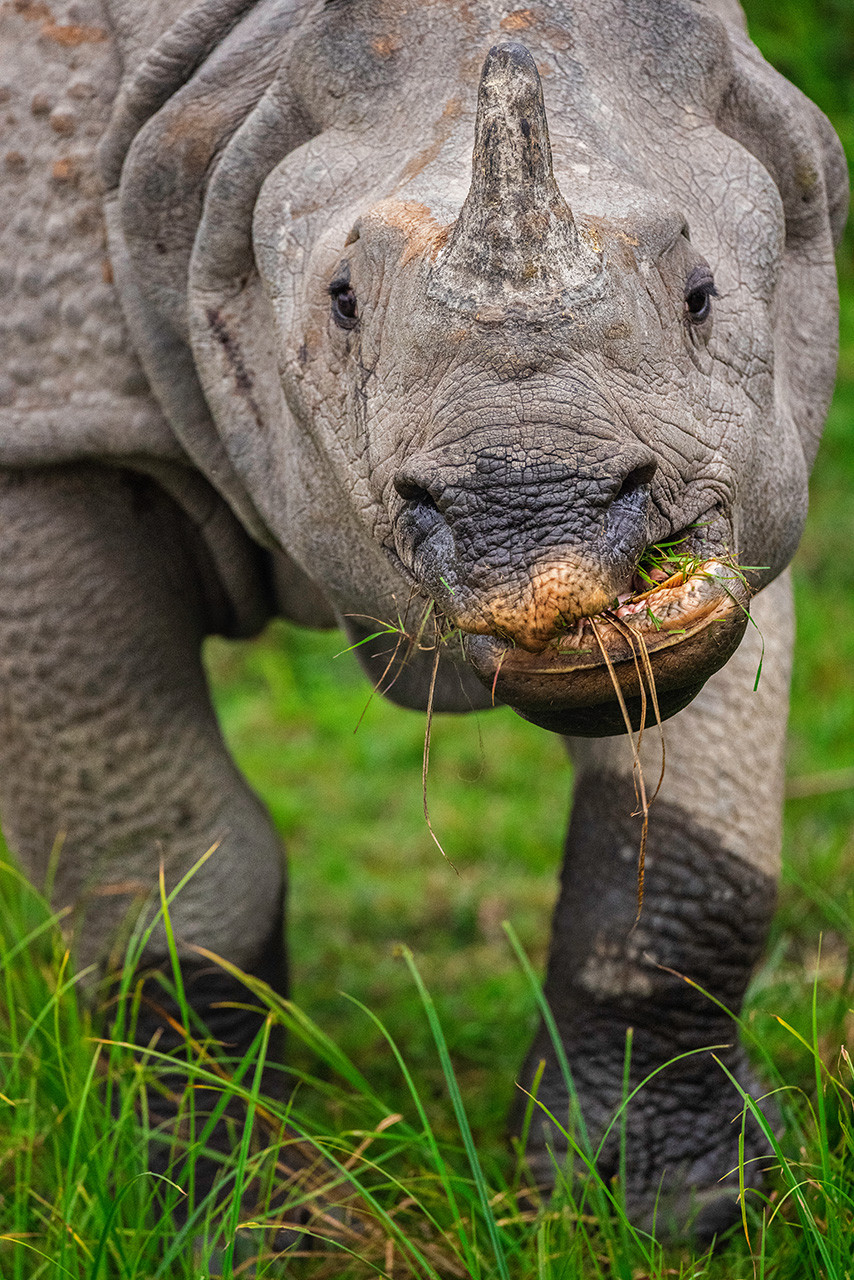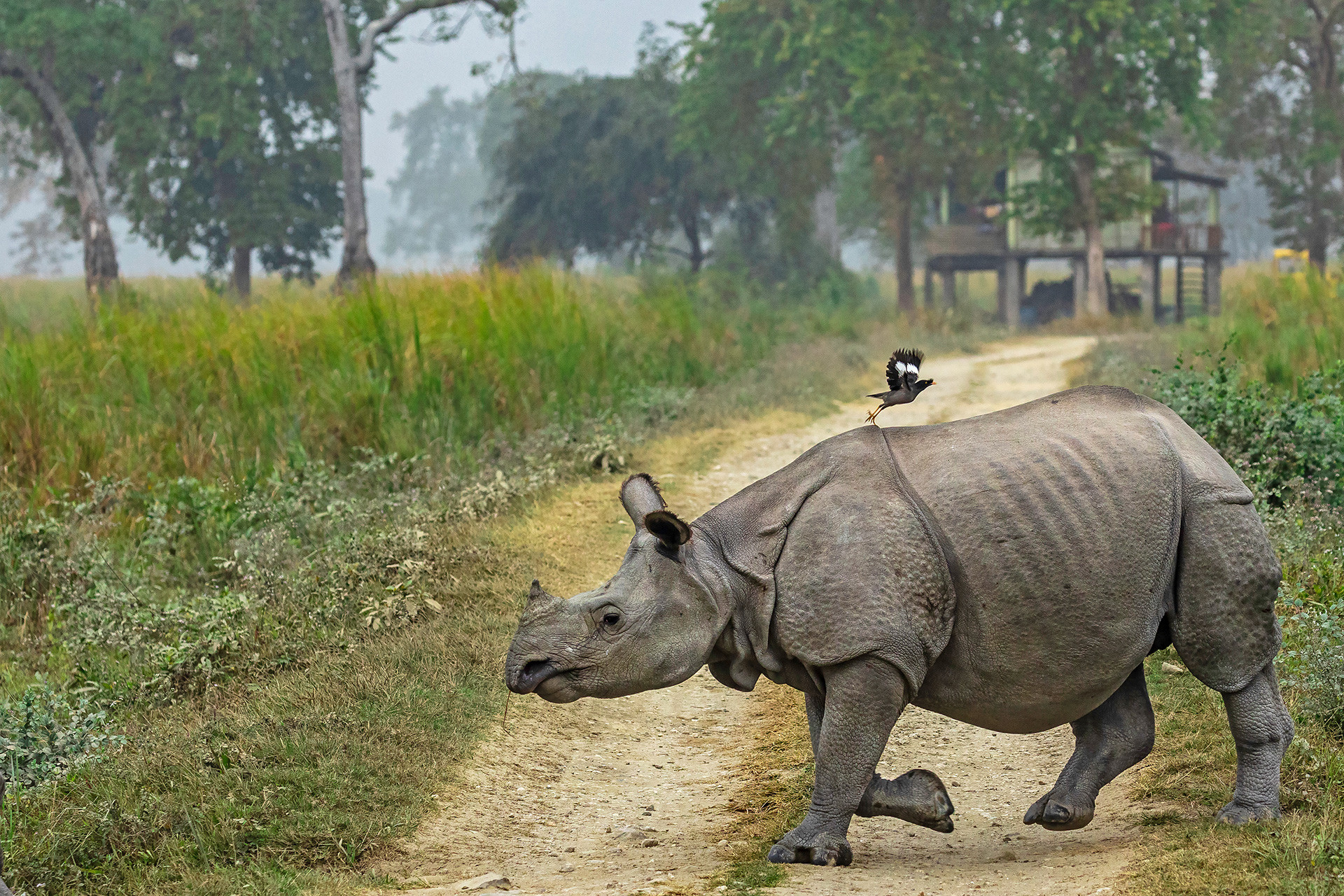Hemanta Mishra, in his memoir, The Soul of the Rhino, writes: “God Vishwakarma picked the best parts of many animals on earth and stitched them together. His creation had the skin of an elephant, the hooves of a horse, the ears of a hare, the eyes of a crocodile, the brains of a bear, the heart of a lion, and horns like Nandi, Shiva’s bull. Vishwakarma creatively twisted, moulded and further modified these parts, even fusing two horns into one.” Mishra further writes, “The result was beyond his expectation, a masterpiece of the art of imperfection.”
The Indian Rhinoceros or the Greater One-Horned Rhinoceros, as the name suggests, distinguishes itself from its African counterparts with the presence of a single horn. To learn more about this unicorn from the Indian wilderness, scroll down.
1 – A Crown of Keratin
The Greater One-Horned Rhinoceros (Rhinoceros Unicornis), commonly found in Assam, India, is one of the largest rhinoceros species on the planet, second to only the White Rhinoceros (Ceratotherium simum). A male Indian Rhinoceros weighs around 2,100-2,200kg whereas a female weighs around 1600kg. An Indian Rhinoceros’ horn is typically 20-61 centimetres long and weighs up to 3kg. Rhinoceros horns are made up of keratin, the same substance as fingernails, and grow continuously, but they lack a bone core. Like the hooves of a horse, rhinoceros horns regrow if broken off. The horn is not exclusively used for fighting but is rather used for searching for food and foraging roots. The life span of this rhinoceros species varies between 35-45 years generally.
2 – Kings of Kaziranga
Indian Rhinoceroses are semi-aquatic and are great swimmers. They often reside in swamps, forests, riverbanks and places that are close to nutritious mineral deposits. The current estimate of the Greater One-Horned Rhinoceros population is at around 3,700, of which 81 per cent is found in the state of Assam and 75 per cent of that figure is in Kaziranga National Park alone. Once considered a highly endangered species, the rhinoceros population in Assam has been able to thrive because of the habitats in the Kaziranga and Manas National Parks. Kaziranga is a vast expanse of tall elephant grass, marshland and dense tropical moist broadleaf forest that is crisscrossed by four major rivers, including the Brahmaputra, and other smaller water bodies.
3 – Like a Bulldozer
The rhinoceros is a megaherbivore and primarily a grazer. A rhino’s diet consists almost entirely of grasses, but it also consumes leaves, branches, fruits and aquatic plants. A rhino needs to consume almost 40kg of vegetation every day. They drink water several times throughout the day. However, in areas where water is not readily available, they can last for several days without it, surviving off the moisture from the vegetation they consume. Rhino lips are semi-prehensile which allows them to grasp grass stems, bend them, bite off the top and then eat the grass. They tackle tall grasses or saplings by walking over the plant, with their legs on either side, like a bulldozer. They then use their body weight to push the plant down to the level of their mouth. Mothers also use this technique to make food accessible to their calves.
4 – Lebensraum
Rhinos have a very distinct method of marking their territory. They drag their feet through their dung, scattering it all over the place, and urinate on the bushes. When rhinos are forced to co-exist in a space that does not allow the establishment of territories of the size that they require, the results can be extremely stressful and even lead to injury and death. To scare off intruders, rhinos usually charge at them. The movement of Indian Rhinoceroses increases rapidly when they are aroused and they can even charge at a speed of 30 miles an hour. Being massive and bulky does not hamper their agility and they can jump or change direction with ease. Rhinos use infrasonic frequencies to communicate with each other. Females also use high-frequency calls when they want to advertise to nearby males that they are receptive to breeding.
5 – The Right to Mate
To earn the right to mate with a female, male rhinos have to fight each other. These fights can be brutal and injuries are common. Female rhinos ovulate once every 28 days and are receptive to males for one or two days out of the cycle. The mating process is typical of most mammals where the male mounts the female from behind and attempts to penetrate her quickly. After mating, the male and female rhino will part ways and not have much more to do with one another. Females usually conceive every two and a half to five years and tend to have one baby at a time, though they do sometimes have twins.
6 – A Mother's Survival Guide
The gestation period of an Indian Rhinoceros is 15 to 16 months, and breeding occurs throughout the year. Rhino calves are born without a horn and remain under the safe protection of their mothers for the first couple of years. Calves are born fairly weak but can stand up and begin walking within minutes of their birth, and even keep pace with their mothers. The mother allows her calf to drink milk exclusively for the first week or two before teaching it to feed on soft, succulent grass. During foraging, the mother and calf keep an eye on each other and maintain a distance between each other, which increases as the calf matures. Males tend to leave their mother sooner than females and once they leave, they will go find a territory of their own.
7 – From the Rhino Jukebox
Rhinos make an array of noises when communicating with each other. Male rhinos grunt and growl at their rivals when they attempt to show dominance. Mothers use panting to call their calf, indicating that it needs to come closer to her. Rhinos scream when they are frightened, it is likely they do this when confronted by poachers. Mothers also scream at their offspring when predators are around and they must ensure their safety. As rhinos are mostly solitary animals, they do not have cause to use their sounds very often. Mostly they are used when two rivals are fighting or between a mother and calf.
8 – A Helping Hand
Rhinos have digestive systems similar to horses and elephants. They eat tough plant matter but they rely on microflora that can digest cellulose and release nutrients like fatty acids that they can then absorb and use for energy. Another example of mutualism is the mynas and egrets that often hitch a ride on these hulks. These birds depend on their large herbivore friends to stir up insects and beetles, which considerably improves their foraging success. In return, these birds feast on the parasites present on the hide of rhinos and they alert their hosts when a predator approaches.
9 – A Nap is Always a Good Idea
Rhinos can sleep standing up or lying down. When they are in deep sleep, they lie down with their feet curled up slightly to one side. Rhinos sleep in intervals, totalling up to about eight hours a day. In shallow waters, rhinos have been seen sleeping with their bodies submerged and their nostrils protruding just above the surface. When the sun is high they can be found resting under the shade of trees or simply wallowing in mud. At night, they alternate between eating and resting.
10 – The Last Stand
All rhino species are threatened by poaching and habitat loss. Even though the Convention on International Trade in Endangered Species of Fauna and Flora (CITES) banned the international trade of rhino horns in 1977, poaching continues to pose the biggest threat to the species. The Indian Rhinoceros was moved from its status of Endangered since 1986 to Vulnerable in 2008 by the International Union for Conservation of Nature (IUCN). Based on a survey conducted by WWF from a meagre population of 75 in 1905, it had increased to more than 2700 in the year 2012. But the hard truth remains that the Indian Rhinoceros population is fragmented and is restricted to less than 20,000 square kilometres.












